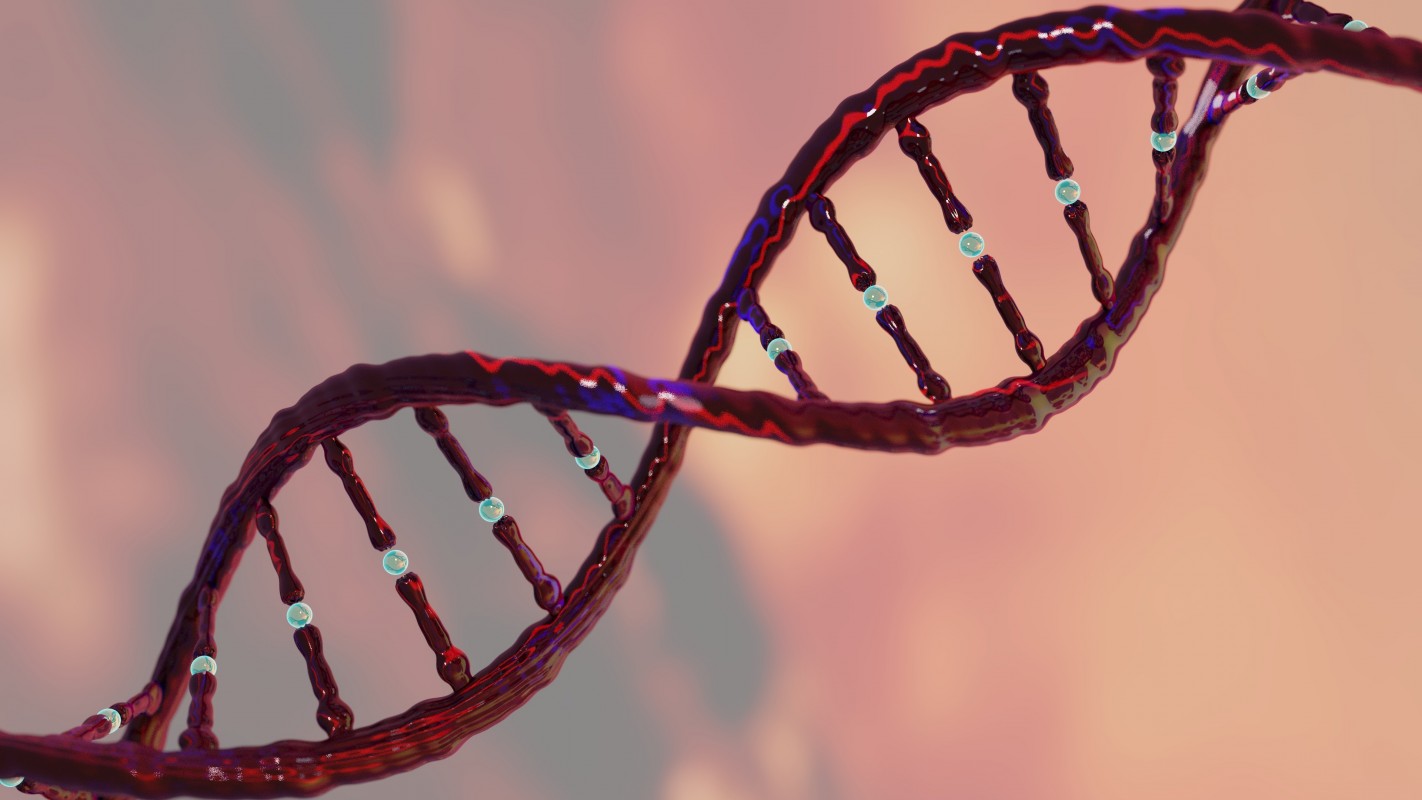DNA and the Case for the Paternity of West Ford
by Linda Allen B. Hollis
 From the time humans first recognized their capacity to pass on characteristics to their offspring, they have wrestled with the puzzle of heredity which has evolved into the science of genetics. DNA, the substance in which genetic information is stored, contains a code that can be read and translated by all forms of life. Molecular scientists believe that the same code has been in continuous use for more than 3.5 billion years. Scientists also know that DNA codes are transmitted from one generation to the next with almost flawless accuracy.
From the time humans first recognized their capacity to pass on characteristics to their offspring, they have wrestled with the puzzle of heredity which has evolved into the science of genetics. DNA, the substance in which genetic information is stored, contains a code that can be read and translated by all forms of life. Molecular scientists believe that the same code has been in continuous use for more than 3.5 billion years. Scientists also know that DNA codes are transmitted from one generation to the next with almost flawless accuracy.
The most infamous and widely-publicized case involving DNA testing was the affair between Thomas Jefferson and Sally Hemings, his slave mistress. The controversy in historical circles is whether there had been a sexual relationship between the U.S. President and his slave that resulted in him fathering some or all her six children. Eugene Foster, a retired pathology professor in Charlottesville, Virginia, who took part in the Thomas Jefferson study, explained the testing that was done in the Jefferson case. Only males carry the Y chromosome and all direct descendants in a line share the same or nearly the same Y chromosome. DNA testing on the Y chromosome can reveal whether two men share a common male ancestor. With this information, scientists can analyze variable markers known to identify different lines of Y chromosomes. The markers are repeated sequences of nucleotides, the letters in the DNA alphabet.
 In an in-depth DNA study of the Thomas Jefferson and Sally Hemings bloodlines, Foster compared nineteen genetic markers on the Y chromosomes of fourteen subjects. From the Jefferson clan, he compared five male-line descendants of two sons of Field Jefferson (Thomas Jefferson's paternal uncle) and his nephews, three male-line descendants of three sons of John Carr (grandfather of Samuel and Peter Carr). From the Hemings bloodline there were five male-line descendants of two sons of Thomas Woodson, and one male-line descendant of Eston Hemings.
In an in-depth DNA study of the Thomas Jefferson and Sally Hemings bloodlines, Foster compared nineteen genetic markers on the Y chromosomes of fourteen subjects. From the Jefferson clan, he compared five male-line descendants of two sons of Field Jefferson (Thomas Jefferson's paternal uncle) and his nephews, three male-line descendants of three sons of John Carr (grandfather of Samuel and Peter Carr). From the Hemings bloodline there were five male-line descendants of two sons of Thomas Woodson, and one male-line descendant of Eston Hemings.
The results showed that the male-line descendants of Field Jefferson and Eston Hemings have identical Y-chromosome haplotypes (the particular combination of variants at defined loci on the chromosome). The DNA study showed a match between a descendent of the Jefferson male line and a descendent of Eston Hemings (Sally's youngest son). However, it showed no match between John Carr, Field Jefferson or Thomas Woodson descendants. In conclusion, the study disclosed that Thomas Jefferson almost certainly fathered a child with his slave and in that vein, a consensus of historians in 2000 declared that Jefferson was the father for all of Sally Hemings' children. The Monticello Foundation seconded that decree in 2001 after conducting their own study. In 2012, Monticello has now incorporated the Sally Hemings family story into the narrative of Thomas Jefferson’s life.
The Sally Hemings claim has given the descendants of West Ford a new impetus in the search for the truth on their claim to the first president. DNA is the only way to truly settle the dispute of West Ford's paternity, yet many barriers stand in the way of this distinctive testing as reliable, proven genetic sources of DNA from Washington and West Ford's body are required.
George Washington, the first president of the United States, has had a significant impact on the American Government and culture. Washington D.C. is the country’s capital; his face appears on the dollar bill and his stone image graces the mountainside of Mount Rushmore. That he, too, might have fathered a child with a slave is controversial and is beset with denials from his many biographers and the historic Mount Vernon Association Ladies’ Association. But, the oral history of the family that states Washington is the biological father of West Ford has been handled down for over two hundred years cannot be ignored.
Unlike Monticello, Mount Vernon does not acknowledge the oral history of the Ford descendants and DNA would be required to test for a genetic link. For a 99% match, DNA from both George Washington and West Ford would be needed. The problem is securing hair samples that are conclusively proven to belong to George Washington for the examination. In June of 1994, the Federal Bureau of Investigation (FBI) was asked to find out if several hair samples came from the head of George Washington. The hair samples were taken from the collections of several historic institutions and the hair strands ranged from the chestnut colored hair of Washington's youth to the snowy white hair of his old age. It is believed that these possible samples of Washington's hair may have come from locks cut for friends and family members to place in their lockets; a tradition common during the 18th and 19th centuries.
The FBI conducted a DNA test on one of the hair samples, using a newly developed forensic technique which included microscopic and DNA sequencing analysis. A sampling of 11 hairs were extracted from larger samples in the collections from the Mount Vernon Ladies' Association, Colonial Williamsburg, Fraunces Tavern in New York City, Tudor Place Foundation, and the DAR Museum.
To get a comparable sample, the FBI obtained hair samples from two white, seventh-generation female line Washington descendants. Their hair was tested because mothers pass DNA information on to all their children, but only daughters pass on the specific code sequence to the next generation. The FBI's final analysis showed that a 1781 sample from Tudor Placehad a limited sequence and they would not exclude this hair as originating from George Washington. The hair samples were in the house from the time it was built between 1805 and 1816. The Tudor Place originally belonged to Martha Peter, granddaughter of Washington's wife. The house was turned over to the Tudor Place Foundation in 1984 to use as a museum and the hairs were found on a piece of paper dated 1781. The hair sample from Colonial Williamsburg was not genetically tested because the hairs were not long enough. Testing of the eight other hair strands were inconclusive because of a lack of DNA.
The Ford Family wants to test with hair samples from George Washington and were denied. As Mary Thompson, the Mount Vernon historian on slave life, explained in a 2013 interview:
“Our director has said that if there is ever a test that would conclusively show that a particular person was the father, that we would submit samples, which was a big step for him. He’s told the (Fords) that he is reluctant to do it until then because every time you do a test like that it destroys original evidence so it’s not there for something that they might want to test later. The other thing is that we’re pretty sure that its gonna show there’s a Washington in the male line. And until we can say “it is” or “isn’t” George Washington . . . if it comes out that there is a male Washington, which we’re pretty sure it will, people will jump all over it and say, “Washington was the father!” Like they did with Thomas Jefferson. We think there is a Washington back there, but it’s not him.”
(Chelsea Elise Hansen, 5-18-2013, Anthropology Honors Project, Macalester College, “I Cannot Tell Your Lie: Alternate and Dominant Narratives of Slavery at Mount Vernon, Virginia).
What is Mount Vernon afraid of . . . one would ask?
West Ford's body and burial site is now unknown for direct DNA testing. During the Civil War, the Mount Vernon Ladies' Association took an ill West from his property on Little Hunting Creek and brought him back to Mount Vernon to tend him. He died a month later. Ford oral family history states that West was buried in the old tomb of George Washington.
In 1997, the family inquired if the old tomb could be opened and West Ford's body could be exhumed for DNA testing. Again, requests were denied, presumably on the grounds that the old tomb was a National monument and could not be opened to the public. But on October 31, 1998, when members of the family visited Mount Vernon for a document search, the tour guide explained that the tomb had been opened and there was nothing inside of it. No coffin, no body, only the dirt floor. The family was informed that the tomb would be opened to the public for viewing in 1999. If West Ford's body was in the old tomb, it was no longer there. First, we ask is why the tomb was opened with none of West Ford descendants in attendance when the Mount Vernon Ladies’ Association knew about the controversy concerning his final resting place? Second, is why open and renovate the tomb for public viewing? Third and lastly, is that The Mount Vernon Ladies' Association claims not to know where West Ford is buried and suggests that he was laid to rest in the mass gravesite that once comprised the slave cemetery. However, Mount Vernon has no records of him being interred there, even though they have burial records on all other blacks, free and slave, on the plantation.
Without conclusive, viable, genetic evidence from either West Ford or George Washington the struggle continues.
"DNA and the Case for the Paternity of West Ford" ©2000 was excerpted from an untitled manuscript by Linda Allen B. Hollis. Bibliography
- Login to post comments
